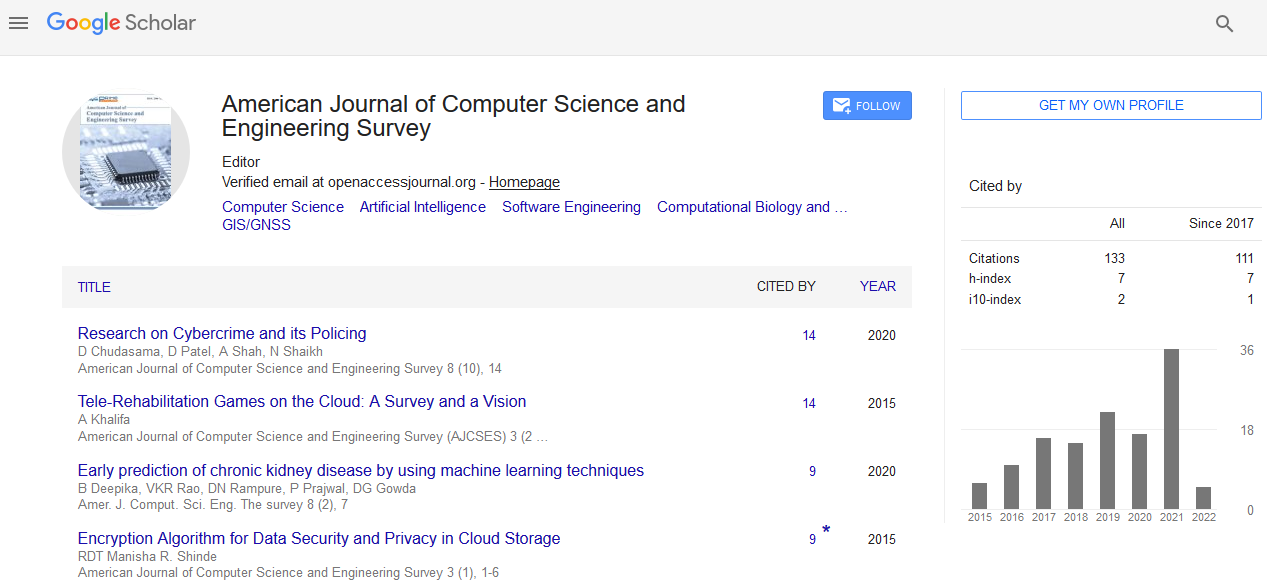Perspective - (2022) Volume 10, Issue 4
Algorithmic Approach in Learning Program Evaluation
Ricardo Garcia*
Department of Computer Science, Universidad de Chile, Santiago, Chile
*Correspondence:
Ricardo Garcia,
Department of Computer Science, Universidad de Chile, Santiago,
Chile,
Tel: 8541279630,
Email:
Received: 29-Jun-2022, Manuscript No. IPACSES-22-14445;
Editor assigned: 01-Jul-2022, Pre QC No. IPACSES-22-14445 (PQ);
Reviewed: 15-Jul-2022, QC No. IPACSES-22-14445;
Revised: 20-Jul-2022, Manuscript No. IPACSES-22-14445 (R);
Published:
27-Jul-2022, DOI: 10.36846/2349-7238-10.4.18
Introduction
Presentation Language program evaluation is the assessment
of parts of a learning setting to accomplish different objectives,
for e.g., Guaranteeing the nature of the program or changing
its components to work on the program. It can likewise show
how compelling the guidance is recommended that a significant
area of study for ESP is research the elements that add
to the achievement or disappointment of courses and to explore
the activities expected to further develop course viability.
Understudies’ decisions about the nature of their growth opportunity
and their perspectives towards that experience are
significant elements to think about in program assessment. Besides,
in the ESP way to deal with learning, dialects are figured
out how to accomplish explicit objectives in reality. A course is
less compelling on the off chance that it doesn’t furnish students
with the abilities they need to achieve their objectives
in reality. Considering this, the helpfulness and pertinence of a
course are key factors that make an ESP course powerful.
Description
Understudies’ advantage and uplifting outlook towards the
course are definitive elements for the progress of the course.
Educating and learning rehearses, educator movement, information
and showing strategies have been viewed as different
variables that impact understudy learning execution in English
courses with regards to advanced education. Moreover, understudy
perspectives toward course materials can be indicators of
their commitment and achievement. Furthermore, Martinovic
and Poljakovic revealed that self-adequacy and capability were
two of her elements impacting understudy mentalities towards
courses. Depiction Materials and strategies Kiely proposed
gathering information through meetings to acquire data on understudies’
view of the nature of their growth opportunity. As
he made sense of, this data gives important understanding into
understudies’ “interests, wants, assumptions, and speculations”
in learning exercises. Kiely likewise found this technique for program assessment valuable. This is to urge understudies
to contemplate the nature of instructing and what is a realizing
setting, and is proposed as a valuable action for English students.
His two gatherings of members took part in this review:
Iranian designing understudies and his ESP professional.
Conclusion
Some minor suggestions, all concerning the translation, were
sent to the two individuals responsible for the back-translation/
cross-cultural adaptation of the questionnaire that incorporated
them into the final version. Ethical Procedures and Considerations
all subjects gave their informed consent for inclusion
before they participated in the study. The study was conducted
in accordance with the Declaration of Helsinki, and the protocol
was approved by the Ethics Committee of the Federal University
of Sao Paulo (Project identification code. The study was
advertised using various social networks managed by professionals
in the area and family members. We also made direct
contact with mothers and professionals who managed blogs/
family mailing lists. General information about the study was
provided as part of the call for volunteers, as well access to the
link to the questionnaire that was open for 3 months. Those interested
in participating entered the MySQL program homepage.
At the initial entry, they were presented with the informed
consent terms and only after agreeing with these in the given
virtual space, they received access to the questionnaire. Therefore,
all participants provided written consent. Categorical variables
were analyzed using Chi-square test. For the identification
of factors related to the main services received and the
main barriers to access to treatment, logistic regression models
were used in the following manner: Variables with p-values in
the bivariate analysis were selected for inclusion in the model,
the variables that entered the model in the previous step
and statistically significant or borderline were retained in the
multivariate model, subsequently, variables that did not enter
the model in the first stage (p-values in the bivariate analysis)
were introduced in the multivariate model and retained if their
p-values were significant or borderline.
Citation: Garcia R (2022) Algorithmic Approach in Learning Program Evaluation. J Aquat Pollut Toxicol. 10:18.
Copyright: ©2022 Garcia R. This is an open-access article distributed under the terms of the Creative Commons Attribution License,
which permits unrestricted use, distribution, and reproduction in any medium, provided the original author and source
are credited.

